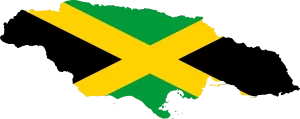Everything you need to know for Jamaica
Geographical position and Climate of Jamaica
Jamaica is an island country situated in the Caribbean Sea, spanning 10,990 square kilometers in area, making it the third-largest island of the Greater Antilles and the Caribbean.
Jamaica boasts a tropical climate, heavily influenced by the warm waters of the nearby Caribbean Sea. The island experiences consistent temperatures year-round, typically ranging between 25°C and 30°C (77°F to 86°F).
However, the climate can vary slightly depending on the region, with the interior of the island experiencing more temperate conditions due to higher elevations. Additionally, Jamaica lies in the hurricane belt of the Atlantic Ocean and is occasionally subject to severe storms during the hurricane season from June to November.
Brief History of Jamaica
Jamaica’s history is a rich tapestry that reflects its status as a melting pot of cultures. Originally inhabited by the indigenous Arawak and Taíno peoples, the island was claimed for Spain after Christopher Columbus arrived in 1494. Spanish rule lasted until 1655 when the island was captured by the English and renamed Jamaica.
Under British colonial rule, Jamaica became a hub for sugar plantations and the transatlantic slave trade, leading to a significant African population on the island. The harsh conditions of slavery eventually led to several uprisings, including the notable Baptist War led by Samuel Sharpe in 1831-32.
Slavery was abolished in 1834, and Jamaica slowly transitioned to a plantation economy with a mix of small farmers and larger estates. The island gained full independence from the United Kingdom on August 6, 1962, but remains a member of the Commonwealth with a parliamentary democracy and constitutional monarchy.
Today, Jamaica is known for its vibrant culture, music, and athletic prowess, with reggae music and the legacy of Bob Marley projecting a powerful cultural influence worldwide.
Religion
Jamaica is predominantly Christian, with the largest denominations being Protestant—including Baptists, Pentecostals, Anglicans, Seventh-day Adventists, and Methodists. The Roman Catholic Church also has a presence on the island. Additionally, there are smaller religious groups such as Rastafarianism, which originated in Jamaica, as well as Islam, Judaism, Hinduism, and Buddhism, reflecting the island’s diverse cultural heritage.
Language
The official language of Jamaica is English, which is used in government, media, education, and business. However, the majority of Jamaicans speak an English-based creole language known as Jamaican Patois (or Patwa), which incorporates elements of African languages, Spanish, and other influences reflective of the island’s diverse history. Jamaican Patois is widely spoken in informal settings and is a significant part of the country’s cultural identity.

Jamaica is a renowned tourist destination known for its stunning beaches, lush landscapes, vibrant culture, and warm hospitality. The island attracts visitors with its alluring mix of natural beauty, from the clear turquoise waters and coral reefs to the misty Blue Mountains and cascading waterfalls.
Places to visit in Jamaica
Before you visit Jamaica
Travel to Jamaica
By Air
- Major International Airports:
- Sangster International Airport (MBJ): Located in Montego Bay, it’s the primary entry point for international tourists.
- Norman Manley International Airport (KIN): Situated in Kingston, it serves as another major gateway, especially for business travelers or those visiting the eastern part of the island.
Airlines from North America, Europe, and other regions operate direct flights to these airports.
By Sea
- Cruise Ports:
- Jamaica is a popular stop for Caribbean cruises, with main ports in Ocho Rios, Montego Bay, and Falmouth.
Visas for Jamaica
General Visa Policy for Jamaica
- Visa-Exempt Countries: Citizens from countries like the United States, Canada, the United Kingdom, and other Commonwealth nations can typically enter Jamaica without a visa for short visits ranging from 30 to 90 days, depending on the country.
- Visa Requirements: Nationals from countries that are not visa-exempt must apply for a visa before arrival. The type of visa required (tourist, business, work, etc.) will depend on the purpose of the visit.
Applying for a Visa
- Application Process: Applicants usually need to submit a completed visa application form, a valid passport, proof of sufficient funds, a return ticket, and any additional documents that support the purpose of their visit.
- Embassies and Consulates: Applications should be submitted to the nearest Jamaican embassy or consulate.
Special Considerations
- Duration of Stay: The duration of stay granted can vary and is at the discretion of the Jamaican immigration authorities.
Best time to visit Jamaica
The best time to visit Jamaica is during the dry season, from mid-December to April. During these months, the weather is typically sunny and warm. This makes it ideal for beach activities, outdoor exploration, and enjoying the island’s natural beauty without the interruption of rain.
This period is also the peak tourist season. The weather conditions are optimal, be aware that popular destinations may be crowded and prices for flights and accommodations can be higher.
For travelers looking to avoid the crowds and possibly find better deals. The shoulder seasons — early December and May — might be a good alternative, though there is a slightly higher chance of rain.
It’s advisable to avoid the hurricane season, particularly from August to October. Then the risk of storms is highest, although Jamaica is often less affected than other Caribbean islands.
Important Information
Capital – Kingston
Territory – 10,991 km2
Currency – Jamaican dollar (JMD)
Time Zone – UTC-5
Population – 2,734,092
Demonym – Jamaican
